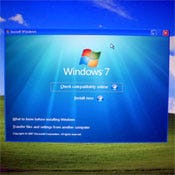Dell Kace Speeds Windows 7 Migrations
K2000 appliance upgrade broadly targets midsized firms with limited IT resources, but may make the most sense for organizations with more than 500 users.


Windows 7 Revealed
(click image for larger view)
Slideshow: Windows 7 Revealed
The migration path to Windows 7 has an increasingly willing shepherd, provided a large enough herd. Dell's Kace unit on Wednesday announced a new version of its K2000 appliance product, with several new features geared toward moving organizations from their current system to the latest Microsoft operating system.
The release, which will go live Friday, includes policy-based capabilities, allowing IT managers to set and enforce rules for migration. For example, particular users or file types can be excluded during migration. It also enables managers to move user data and update the OS without running the old software, and automates hardware driver checks and downloads.
Dell Kace's target market is midsize firms that lack a dedicated systems manager or team, and instead add that responsibility to the long list of duties for an IT generalist.
"We call it the wearing-many-hats complex," said Wynn White, VP of marketing for Dell Kace. The company's definition of the midsize market is decidedly broad, ranging between 100 and 10,000 nodes.
To be clear, Kace was already servicing Windows 7 migrations, and that is not all their appliances do. But the company said that the K2000 enhancements in version 3.3 were driven largely by the Windows 7 shift.
Steve Brasen, senior analyst at Enterprise Management Associates, agreed: "When you look at the new features, they really revolve around Windows 7 migration," he said.
Kace's own research shows widespread Windows 7 interest among IT managers: 87% of IT professionals it surveyed in January said they planned to deploy the OS. A similar survey in October found that 85% plan to implement Office 2010.
"I think there's very little resistance in the marketplace to adoption," White said. He attributed that in part to the large number of firms that skipped Vista and are facing the end of XP's support lifecycle in 2014. "Unless you want to be on an unsupported OS, you need to act now."
Kace offers two pricing options: $4,500 for 100 seats or $39,000 per appliance. The latter only makes sense for large enterprises. For smaller firms, even the 100-seat price tag may be worth shopping around.

Windows 7 Revealed
(click image for larger view)
Slideshow: Windows 7 Revealed
"Their pricing is extremely competitive," Brasen said "The challenge comes in below 500 end points." Brasen said that the return on investment (ROI) diminishes as companies approach 100 end points, when compared with some of the per-seat options on the market. As a result, Kace may be best suited for organizations above that 500-seat mark. "I think that's the niche that they're really trying for," Brasen said.
Brasen noted, however, that if a vendor's feature set makes particular sense for an organization, then the ROI may not be strictly a matter of dollars and cents in relation to headcount.
That was true for South Coast Water District (SCWD), which provides water and sewer service in southern California. IT manager Bryon Black said his public agency was attracted to Kace's appliance model and has found success using its scripted installations.
SCWD is about halfway through its migration of around 150 end points. Black estimated that migrating a single user before Kace would take about a half a day, and now that's down to 20 minutes. When weighing the costs of deploying Kace, Black said that time saved was the critical factor.
"We kept a careful eye on how much less work this was going to be for us," he said, adding that SCWD didn't have the resources to hire the additional headcount it would have needed to avoid business-as-usual disruptions during migration. Black's IT department numbers two -- including him. "We've saved a person, at least."
Black did point out that there was a significant learning curve in automating with Kace, but said that's likely the case with any vendor in the space. "That part is painful for anyone, I think."
"With a team of two people, we're knocking out about three [users] per day and keeping up with our regular workload," Black said. "I'm pretty stoked about that."
For Further Reading
3 SMBs Illustrate The Different Approaches To Windows 7 -- And Other Top Tech Issues
About the Author(s)
You May Also Like






